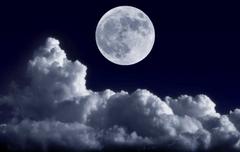 The closest and largest full moon of the year, called a "supermoon" peaks on Saturday, June 23, 2013.
The closest and largest full moon of the year, called a "supermoon" peaks on Saturday, June 23, 2013. A supermoon occurs when a full moon coincides with the moon being closest to Earth in its orbit, also known as perigee. The near perfect timing of these two celestial events makes the moon appear larger and brighter in the night sky.
The moon will be closest to Earth at 7:32 a.m EDT on June 23, but you will be able to see the supermoon shining bright on Friday, June 22 as well.
Saturday's supermoon will appear 14 percent larger and 30 percent brighter than a regular full moon does, NASA scientist Michelle Thaller tells ABC News.
While a supermoon does bring extra-high tides, the extra gravitational force is not big enough to produce any significant changes in seismic activity for those who are concerned that the moon's close proximity to Earth will trigger earthquakes and volcanic eruptions.
*SEE ALSO: Spectacular Images From The Herschel Telescope *
Join the conversation about this story »
Reported by Business Insider 6 hours ago.